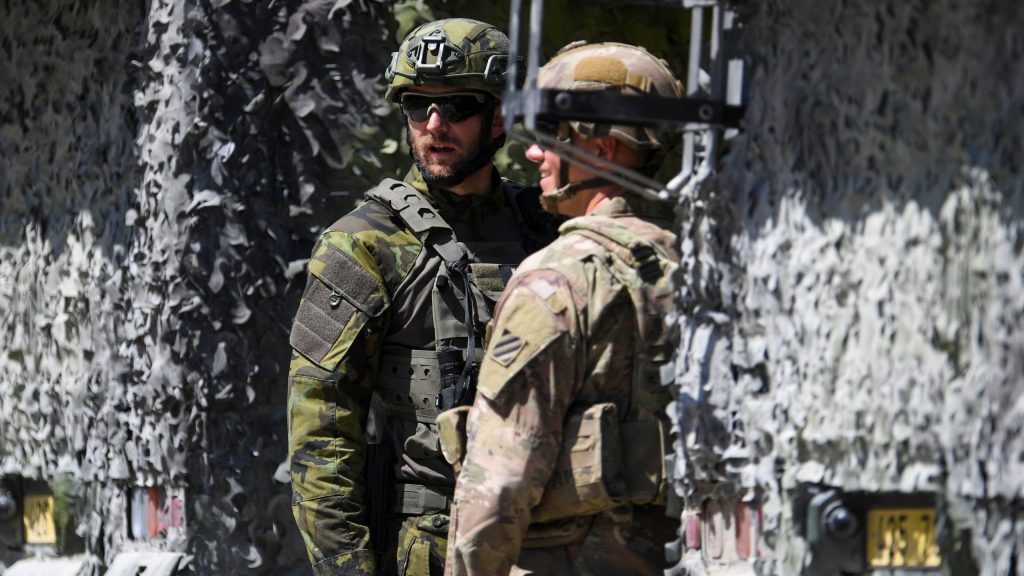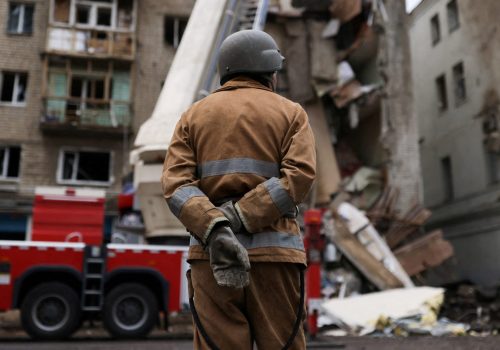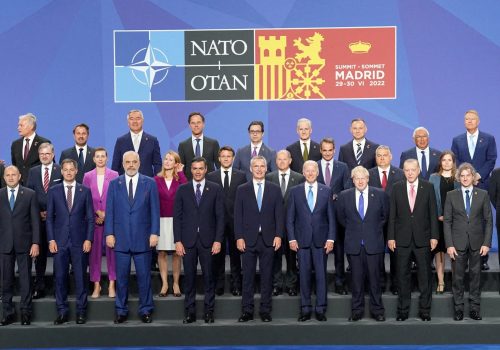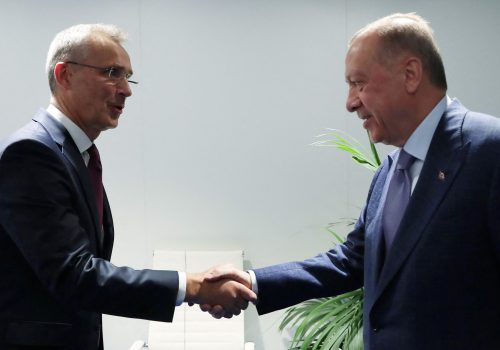Last month’s NATO Summit, which featured the release of the Alliance’s new Strategic Concept, was a remarkable success. Thanks to strong leadership by Secretary General Jens Stoltenberg and US President Joe Biden, the Alliance remains united despite an array of new strategic challenges.
The concept’s three core tasks—collective defense, crisis management, and cooperative security—essentially remain intact from the 2010 version, but with new emphasis on the first. The new update reaffirms NATO’s intention to protect the rules-based international order currently under threat by autocratic powers, and further recognizes challenges in cyberspace, space, and maritime trade routes, among other areas. Russia is singled out as the biggest direct threat, while China is characterized for the first time as a “systemic challenge.”
As for the second and third core tasks, crisis management now includes prevention while cooperative security will focus more on high-value partners.
But now the concept—which marked a sea change from 2010 by shifting from a focus on fighting terrorism to great-power competition—actually needs to be implemented. And some of the sidelined issues, such as deciding when to engage in crisis-management operations, managing security in the Arctic, maximizing common cyber defenses, defining NATO’s role in dealing with climate change, building societal resilience, and stabilizing the Western Balkans, all require greater attention.
Securing the front lines
Start with the first core task: deterrence and defense. Russia’s wanton destruction of Ukraine underlines the fact that NATO’s existing tripwire deterrence strategy is no longer viable. That strategy envisions placing minimal forces forward, thus effectively allowing an adversary to occupy allied territory which would subsequently be retaken once NATO’s reserves are fully mobilized. But NATO front-line states are understandably unwilling to risk the kind of destruction Russia has imposed on Ukraine.
Additionally, Russia’s strengthened force posture in Ukraine, the Black Sea, Moldova, and Kaliningrad reduces some of the Alliance’s strategic depth and makes front-line allies more vulnerable.
For both of these reasons, the new strategic concept moves in the direction of deterrence by denial, which means deploying adequate forces forward to stop an attack in its tracks. To begin implementing this approach, NATO has doubled the number of front-line nations in which enhanced forward presence battle groups are deployed, bringing the total to eight. But these battalion-sized battle groups are far from adequate to blunt a possible Russian attack. Brigade-sized (and in some cases, division-sized) NATO forces will need to be stationed along the front line.
Behind these strengthened front-line forces, NATO dramatically increased the size of its Response Force from forty thousand to three hundred thousand highly ready forces and has renamed it the Allied Force. But this new readiness goal is far from being met. In fact, the previously agreed and more modest “4X30 Readiness Initiative”—which envisions thirty army battalions, thirty air squadrons, and thirty major naval combatants ready to fight in thirty days—has not yet been fully implemented. Meeting these new, more ambitious readiness goals will be critical before building up the full Allied Force. Readiness-reporting mechanisms, including the ability of ready forces to sustain their capability over time, will need to be re-instituted to assure these goals are completed.
The new force will also require several additional elements. NATO needs an action plan for the stalled Mobility Initiative, which is designed to overcome bureaucratic and logistical hurdles, to move ready forces forward. This ability needs to be increased, cross-border procedures simplified, infrastructure upgraded, and command-and-control strengthened. The Alliance needs to pre-position forward significant amounts of military equipment to overcome the remaining mobility limitations, and it needs to create a new command structure to coordinate the new force.
NATO will also need to institute a new round of military planning to organize these forces and assign them to the new defense plans, while determining the “Who-does-what?” question among the soon-to-be thirty-two allies. Nations need to start repositioning troops and increasing readiness through intense training and exercises.
Defense budgets need to keep rising to implement the new deterrence strategy even as difficult economic times approach. Old debates about European strategic autonomy and burden sharing now need to be set aside—with a new focus on establishing specific goals for European strategic responsibility.
For its part, the United States plans to increase the size of its deployments in Europe, including a new corps headquarters in Poland, an additional army brigade in Romania, extra ships in the Mediterranean, and two additional squadrons of F-35 fighter jets in the United Kingdom. Importantly, it will need to deploy additional forces to the Baltic states, where deterrence is least reliable and incentives for Russian intervention are greatest.
When it comes to nuclear deterrence, the new concept primarily echoed the banal language from the 2010 iteration; this is inadequate to deal with an adversary who constantly rattles the nuclear saber. The new concept does indicate the need to reconnect the nuclear domain with NATO’s conventional domains, cyber, and space as part of a so-called multi-domain approach to deterrence. But to do this, NATO will need to revive its nuclear culture, restructure its doctrine, and integrate nuclear exercises and capability planning into its overall effort.
All this while the Alliance will need to focus on the war at hand. Currently, individual allies provide military aid to Ukraine while NATO only considers offering non-lethal and cyber assistance. This has worked reasonably well so far, since most nations have contributed weapons, but Ukraine is losing the battle for the Donbas (what might be called “phase two” of this war). If Russia is able to continue with an offensive through Odesa, a “phase three” will require a bolder NATO approach to defeat it.
Dealing with friends and rivals
In terms of other major powers challenging NATO, the concept highlights China’s moves to subvert the rules-based international order and Beijing’s deepening strategic partnership with Moscow. It notes that allies will work together to meet these systemic challenges—but stops there. NATO must now develop a China plan to specifically address these challenges while maintaining constructive engagement with Beijing. It could take a first step by creating a much deeper partnership with like-minded Asian countries, and of a new NATO-China Commission to coordinate engagement.
Next, the implementation of summit decisions should focus on the European Union (EU). Despite the EU adopting its own Strategic Compass recently—and the clear need for greater coordination amid a major security crisis in Europe—the summit documents contained no separate NATO-EU declaration on the “how and what” as they did in recent years. Recognizing the need for consensus in both organizations, leaders of those institutions now need to use the Strategic Compass and the Strategic Concept to design a detailed work plan for future cooperation. They need to develop a sense of buy-in from all members and overcome institutional difficulties created by a few dissenting states.
NATO’s new concept reiterates that its door will remain open to new members—but more work needs to be done here too. The immediate task is completing the membership process for Finland and Sweden. While Turkish President Recep Tayyip Erdogan lifted his objections at the summit, he has reserved the right to hold the process up again during the required ratification process if he feels his deal with the Nordic countries isn’t being implemented. If he continues to insist on extradition of Kurds living in Sweden, the allies will have to manage a new membership crisis. Meanwhile, despite the concept reiterating the fact that Ukraine and Georgia could eventually become members, that prospect appears distant. Engaging those two prospective members will require creative alternative approaches, such as commitments of significant long-term arms supplies and stronger diplomatic support.
Finally, NATO leaders also explicitly stated their intention to keep the door open to dialogue, including on disarmament and arms control, with both Russia and China. Although deeper political engagement with Russia is unlikely so long as it wages war in Ukraine, plans should quietly be made on issues such as arms control and incident management for eventual implementation once the climate is right. The combination of deterrence and defense on the one hand and dialogue on the other is a combination that has served the Alliance well in the past.
In addition to implementing summit decisions, NATO needs to concentrate more on several areas that received inadequate attention in Madrid. For example, the concept did not address how and under what circumstances the Alliance should intervene in Ukraine-like crisis management operations in its own neighborhood. This key issue was papered over at the summit.
While the concept focuses allied attention on the global commons like maritime trade routes, cyberspace, and space, it hardly mentioned the Arctic. Nor did it create a NATO cyber force, thus leaving cyber defense primarily to individual nations. The Western Balkans also need NATO’s urgent attention. Finally, climate change was cited as a defining challenge of our time, but no specific action was suggested.
NATO can rightly be proud of its accomplishments at the summit—but now is the time for it to accelerate implementation of its decisions and attend to matters that it left behind. Otherwise, its achievements will simply fade away.
Hans Binnendijk is a distinguished fellow at the Atlantic Council. He previously served as special assistant to the US president for defense policy and as director of the Institute for National Strategic Studies.
Timo S. Koster is an independent strategic advisor. He previously was director of defense policy at NATO and ambassador for security policy and cyber for the Netherlands. He is a senior fellow at the Atlantic Council. Follow him on Twitter @TSKOS.
Further reading
Mon, Jul 11, 2022
Four (updated) ways the war in Ukraine might end
New Atlanticist By Barry Pavel, Peter Engelke, Jeffrey Cimmino
Four months later, Scowcroft Center experts reexamine their forecasts and suggest how to amend them in light of recent developments.
Thu, Jun 30, 2022
Our experts decipher NATO’s new Strategic Concept
Markup By
What were the allies really saying amid all the jargon? And what did they leave out? Our experts carefully combed through the document and dropped their insights in the margins.
Tue, Jun 28, 2022
What Turkey won with its NATO leverage
Fast Thinking By
Ankara got exactly what it wanted in exchange for paving the way for Sweden and Finland to join the Alliance.
Image: Soldiers participate in the Dynamic Front 22 Multinational Integrated Fires Exercise organised by the 56th Artillery Command and multinational allies and NATO partners at the training area in Grafenwoehr, Germany on July 20, 2022. Photo by Andreas Gebert/REUTERS



